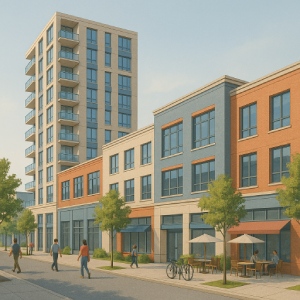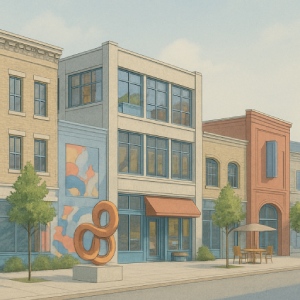What is Changing in City Life?
Around the world, cities are evolving. It does not matter whether you are heading to cities in developing countries, such as Nairobi, or moving to the big cities like New York. Cities are dynamic, and what was the norm yesterday is today’s history. So, what changes are taking place in Canada?

From Sprawl to Rise
In the past, land around the cities was in high supply. As such, these urban centers grew in a sprawl pattern such that people would put up single-unit developments. It was quite the norm for families to occupy single units. But as more people sought to live in or near the cities, such developments were no longer seen as feasible.
For one, with the growing population, the housing demand had gone up, thus pushing developers to put up more units in what was now becoming a scarce land supply around the urban regions. Secondly, it became clear that single-unit developments were much costlier than putting up multi-purpose developments that housed more people. And of course, environmental concerns came about, where developers started thinking about how they could reduce their carbon footprint.
As a result, Canadian cities have slowly shifted towards mid-rise and high-rise developments to maximize the use of the small land parcels. And in areas that were predominantly single-family homes, there has been an increased redevelopment strategy where developers are tearing down existing buildings to pave the way for bigger multi-family developments.
Reduced Car Dependency

Remember when most people would drive to and from work? Back then, the transit systems had been designed with commuters in mind, as most people had to travel long distances to make it to their jobs or run errands. At the time, this worked as public transportation was not very developed, and traffic was not much of an issue. Again, cities were still growing, and not many people were cruising down the roads during rush hour.
But the thing with cities is that they grow exponentially. Soon, the bigger Canadian cities were grappling with traffic congestion as more people were using the roads. But that was not the only problem. With more people paying attention to environmental changes and the need for sustainability, there was a push for provincial governments to step in and address this growing problem.
The solution? They built new transit lines, such as subways, to complement the roads, thus allowing people to make it around the cities without depending on their cars. These new lines, which are still under construction in many cities, have changed the real estate sector significantly. Not only are people putting up more commercial developments near these stations, but more people are choosing to live near these areas just for the convenience. And the cherry on top has to be the reduced traffic snarl-ups during the rush hours.
The Rise of Mixed-Use Developments

Besides developing single units, developers would also put up single-use buildings in the past. The thinking behind this was tied to the zoning laws, which advocated for separation. For example, if someone wanted to put up an industry, they had to do so in an industrial zone so that their activities would not disrupt residential or commercial uses. As such, back then, there was a clear distinction between residential blocks, industrial zones, and commercial parks.
So, why did this change? Let’s start with the commutes. With land uses so separated, people had to travel quite far to make it to work or run other errands. Not only was this time-consuming, but it was also expensive. To add to this, there was the issue of economic instability. Say, for example, that retail spaces suffered a decline in demand. Investors in this area would suffer a huge loss as they heavily relied on one sector to generate income. Businesspeople also faced hard times when this happened.
Eventually, people got tired of this separation. They wanted more walkability. They craved a more vibrant community where not everything was the same. Most importantly, they wanted a stable ecosystem that did not rely on one sector to support the local economy.
Developers stepped in with two types of mixed uses. The first was vertical mixed-use, where one high-rise building serves as a hub for different functions. For example, such a building may have office floors on the lower part of the building and residential apartments towards the top. The second option was horizontal mixed use, where developers would put up different buildings in one complex, with each building serving a different function. Regardless of the approach, these mixed uses are not only convenient to the residents but also to the businesspeople who now get a customer base right at their doorstep.
Adaptive Reuse of Commercial Developments

The hybrid work model, which has become quite standard in many organizations, has changed the way people work. Let’s walk it back to the early 21st century and the decades before that. In those times, organizations heavily relied on the physical presence of their employees, who served various support functions. As such, they had to lease or develop easily accessible office spaces, not just for their clients but also for their employees. And in Canadian cities, the most sought-after office spaces were those in office parks or downtown areas. Developers would put up commercial buildings in these parts as their main priority, putting off residential buildings, as these were seen as secondary land uses.
But as technology improved, organizations realized that they could easily hire remote employees or use hybrid work models that allowed them to run much smaller offices without sacrificing the quality of their services or products. Moreover, this approach enabled them to save money, not just on the leases but also on other operational costs. Over the years, many of them downsized, resulting in several vacant office spaces in central business districts.
Developers were quick to note the trend, and having looked into the most feasible options, they started converting these older commercial buildings into rental units. After all, even with remote and hybrid work models, the urban population was still growing, and residential spaces were in high demand. Most of these conversions took place in downtown areas, which sparked interest among house-hunters who were also looking for ideal locations. This trend continues to take shape as more people want to live smack in the middle of the city, where everything is accessible within walking distance.
Emergence of Cultural Districts

For many years, people flocked to museums and theaters in search of art. And while this helped them stay in touch with their roots, these spaces were few and far between. For one, they were often the result of government projects, and these would take a long time to come to fruition. And secondly, because of their central locations, the project leads often maximized the use of the space such that one venue would hold an extensive art collection. So, a visit to one location was enough to account for a day well spent.
This setup worked well until it didn’t. Part of its downfall was the neglect of neighborhood culture. Various cultures came up over the years quite organically. But since these were often in historic districts, these cultures did not go mainstream, especially if the districts were neglected. So, eventually, people got tired of the stand-alone cultural projects, which only showed one side of the picture. They wanted more. They had grown to appreciate the role of creatives and how they helped them find their own identities. They had come to value the arts and no longer wanted to wait until another huge government project came around.
So, they started paying more attention to the arts and culture spaces in their neighborhoods and appreciating them more. They wanted to be in the same spaces as the creatives, to see them work on their next projects, to have a chance at supporting them, and to be part of the organic stories. In fact, the neighborhoods that were known for their vibrancy attracted more attention from residents and became the more desirable real estate markets. And soon enough, people started paying a premium for spaces in these neighborhoods. Even now, older urban areas are gaining a lot of traction in the markets as more people seek to move closer to areas with more authentic art.
The Growth of Third Spaces
At first, developers were so keen on making the most out of the scarce urban land that they pushed public spaces to the back burner. In fact, they would often focus on putting up the core development, and if they had any residual land left, they would carve this out for public spaces, like green spaces. Initially, this optimal land use was seen as a great way of addressing the land scarcity issue. But like we said, cities are dynamic – and that’s because people’s needs change.
Residents soon started wanting an in-between space. They wanted a place to be where they were not at work or at home. They wanted a place where they could just be and connect with others or even take some time off to be by themselves. And developers realized they could meet this need with some public improvements to their designs, such as pedestrian-only streets and plazas. With these interwoven green spaces, residents got to enjoy beautiful and walkable spaces where they could engage with the community around them, which enhanced the quality of their lives. And with many people living in smaller homes, these spaces make quite a difference to their lives.
The Departure from Polycentricism
The biggest change in Canadian cities to date has been the move towards polycentricism. But what does this entail? Back when cities first developed, their downtowns were their cores, as this is where most services and jobs were located. Other land uses grew around these cores, including the residential areas. But as cities grew, accessing these cores became quite hard due to the high traffic to and from these centers. What’s more, the cost of land in these centers grew so much that many businesses and developers had to move outward in search of more affordable land parcels and leases. Over the years, this led to the development of satellite cities, each with its own core and residential housing, all of which were connected to the main cities through transit. And with more people moving to these satellite cities in search of shorter commutes and cheaper rents, they grew quite fast. More satellite cities are still coming up, resulting in the expansion of job and Canadian real estate markets.
